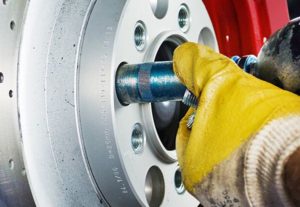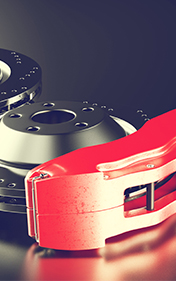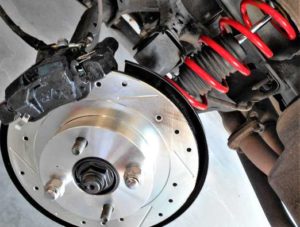Comprehensive Guide to Brake Repair Services in VA

An effective brake system is essential to vehicle safety. So, when it comes to maintaining your vehicle, regular brake service should be a top priority. This auto service is crucial to the longevity and performance of a vehicle's brake system.
In this in-depth guide, we’ve covered everything you need to know about brake repair services, from the importance of regular inspections to the different types of brake service available. With this information, you'll have the knowledge and confidence needed to keep your vehicle's brakes in top condition and be better prepared to address any issues that may arise.
The Importance of Routine Brake Inspections
Doing everything you can to keep your brake system in optimal condition is vital, not only for your safety but the safety of your passengers as well as the life of your vehicle. Braking components, unfortunately, don’t last forever. But thorough routine brake inspections allow for minor issues to be caught early and addressed, thus ensuring that no brake components are overly worn and that the system stays in optimal condition longer.
We recommend bringing in your vehicle for a brake inspection every 6,000 miles or six months, whichever comes first. You should also come in for an inspection immediately if you notice any new issues when braking (see more on this below).
Exactly how frequently brake service is required is different with every vehicle. How quickly your brake components wear is impacted by factors such as your driving habits, the type of brake pads being used, and your driving conditions.
Signs That Your Vehicle Needs Brake Service
Your vehicle's braking system is one of its most vital safety features, and failing to keep it in good condition can lead to disastrous consequences. One way to help keep it operating at its best is to be aware of the early warning signs of trouble.
Here are some of the most common indicators that your vehicle may need brake repair services:
Brake Warning Light is Illuminated
If the brake warning light on your dashboard illuminates, it's a clear indication that something is wrong with your braking system. This light is designed to alert you to a variety of issues with your brakes, such as a low brake fluid level or overly worn brake pads. Ignoring this warning light can lead to much more severe brake problems, so it's essential to address the issue as soon as possible.
Squealing, Grinding, or Clicking Noises
If you hear squealing or grinding noises when braking, it's a sign that your brake pads are overly worn down and need to be replaced. These noises occur because of the metal-on-metal contact of the brake pads against the brake rotors, which can significantly damage your rotors if left unchecked. A clicking or rattling noise is usually due to a loose brake caliper part that holds the brake pad in place.
Soft or “Spongy” Brake Pedal
Normally, when pressing on the brake pedal with your foot, you should feel a good amount of resistance. So, if your brake pedal feels soft, aka “spongy,” when you apply pressure, it can indicate air in the brake lines or a low brake fluid level. This issue can reduce your vehicle's stopping power and increase your stopping distance, making it significantly harder to control your vehicle.
Vibrations or Shaking
If your vehicle vibrates or even shakes when you apply the brakes, it's a sign that your brake rotors are warped or uneven. This is another issue that can make it harder to control the vehicle when trying to stop.
Your Vehicle is Pulling to One Side
A vehicle’s brake pads all wear at different rates. Sometimes when there is an overly worn pad on one side, it can cause the vehicle to pull to that side when braking. But there are a couple of other things that can also cause pulling. If this is happening, have your vehicle checked out as soon as possible to pinpoint and address the cause.
Brake Fade
This term refers to the reduction of the brake system’s stopping power. This is evident when it takes noticeably longer to stop the vehicle when the brake pedal is pressed. Brake fade can be caused over time by repeated or sustained brake use, especially from braking at high speeds or when carrying heavy loads.
Leaking Brake Fluid
Brake fluid should never be leaking from the underside of your vehicle. If it is, you’ll notice light yellow or light brown fluid on the ground.
Overall, it's important to be aware of the warning signs that your vehicle needs a brake service. Ignoring these issues can quickly lead to more severe brake problems, which can not only compromise your safety on the road but also be more costly to fix.
The best way to assess the condition of your brake system is to have it inspected by an ASE-certified mechanic. Auto service experts, like you’ll find here at Hogan & Sons, can accurately pinpoint exactly what is wrong and what brake service or repair may be needed.

The Different Types of Brake Service
Along with knowing the warning signs to look out for, it can also be invaluable to have a deeper understanding of the different kinds of brake services that are offered at professional brake shops.
Having this knowledge can help you to make informed decisions about when and how to have your brakes serviced. It can also help you to communicate effectively with your mechanic to get the best possible service. This can save you money and ensure that your brakes are properly maintained, thus ensuring the safety of you and your passengers on the road.
Here is a brief breakdown of the different brake services:
Brake Pad Replacement
Brake pads are the component that most often need replacement within the braking system. Over time, they wear down and lose their effectiveness, resulting in reduced stopping power. During a brake pad replacement, the mechanic will remove the old, worn pads and replace them with new ones. It's important to note that different types of brake pads offer different levels of performance, so it's crucial to choose the right ones for your vehicle and driving habits.
Brake Rotor Resurfacing or Replacement
The brake rotor is the round disc that the brake pads clamp down on to stop the vehicle. Over time, it can develop uneven wear, resulting in noise or vibration while braking. To restore optimal braking performance, as long as there is enough metal left, the mechanic can resurface the rotors.
This service, also sometimes referred to as “turning” the rotors, involves using an extremely sharp bit to cut into the rotor’s surface while it spins on a lathe. This creates a smooth, even surface again, which then restores the brake pads’ ability to effectively generate the friction needed to stop your vehicle.
If the rotors are overly worn and do not have enough metal left to effectively resurface them, they will need to be replaced.
Repair or Replacement of Brake Calipers
The brake caliper holds the brake pads and applies pressure to the rotor. A malfunctioning caliper can cause uneven braking, your vehicle to pull to one side or even a loss of stopping power. If the caliper is damaged, it needs to be addressed ASAP, whether that means replacement or repair. In some cases, it can be repaired by simply replacing the seals or pistons.
Brake Line Repair or Replacement
The brake lines carry the brake fluid between the master cylinder and the calipers. If there's a leak or damage to the lines, it can result in a spongy brake pedal and a loss of braking power. The mechanic will inspect the brake lines and repair or replace them if necessary.

Determining When Brake Pad Replacement is Needed
As mentioned above, the friction generated by daily use of your brake system naturally wears down the brake pads. Totally worn-out or defective brake pads can jeopardize the safety of you and your passengers while out on the road. Brake failure causes 300,000 accidents per year. You don’t want to be included in that statistic because you disregarded the need for brake pad replacement. But many drivers wonder when exactly the pads should be replaced.
When brake pads are new, they have 12mm of friction-generating material that helps to slow or stop your vehicle. Generally speaking, when the mechanic is performing a brake inspection, they will suggest a brake pad replacement if the friction material’s thickness is worn down to 4mm or less. The last thing you want is for the metal on overly worn brake pads to start taking gouges out of your rotors. So, it’s important to replace them before there is no more friction material.
Most drivers don’t normally measure the thickness of their own brake pads. That is why keeping up with regularly scheduled brake inspections and trusting professional brake repair specialists in Virginia to measure this is so important. These experts have the knowledge and experience to keep your vehicle safe on the road, perform the necessary service and repairs, and provide insight on how to extend the life of your brake pads and other brake system components.
The Three Main Types of Brake Pads
Most brake pads today are made of one of three types of friction material: metallic, ceramic, or organic. Each type of brake pad has its pros and cons, so, when it comes to selecting one for your brake pad replacement, being more informed and asking your mechanic for advice is important. Here’s a quick overview of the three types:
Metallic Brake Pads
- Type most commonly used
- Made of metals and bonding materials
- Extremely durable
- Good performance overall
- Good heat-dissipation capability
- More affordably priced compared to other types
Ceramic Brake Pads
- Designed for use on more high-performance vehicles
- Made of a combination of ceramic and bonding materials (and, sometimes, cotton fibers)
- More lightweight compared to other types
- Extremely durable
- Best heat-dissipation capabilities
- More expensive, in comparison to other types
Organic Brake Pads
- Are made of recycled materials like rubber, glass, and/or resin
- Is the most environmentally friendly option
- Wears down faster than other types
- High heat-dissipation capabilities
The type of vehicle, your driving habits, and your budget will all impact which brake pads may be the best option for you. Don’t be afraid to ask your mechanic for input. They can help you choose the right brake pads for your needs.
How to Choose a Good Virginia Brake Service Provider
As mentioned above, when it comes to your vehicle's safety, the brakes are undoubtedly one of the most crucial components to properly maintain. That is why it is essential to find a reliable brake shop that you can count on to ensure the proper functioning of your brakes. Here are some factors to consider when choosing the right shop for brake service:
Certification and Experience
These two things are essential requirements to look for when choosing a brake repair service provider. Always look for an auto shop whose mechanics are ASE-certified and have extensive experience in brake service. Certified technicians have received the proper training and have the necessary skills to handle all aspects of the repair and maintenance of different brake systems.
Reputation and Reviews
One of the easiest ways to determine an auto service shop’s reputation is by checking its online reviews and ratings on third-party sites. Online reviews can provide you with a wealth of information regarding the quality of service provided. You want to look for a shop with a large number of positive reviews and a high overall rating.
Warranty and Guarantee
A reputable brake service provider will offer some form of warranty or guarantee for their services. Warranties can provide peace of mind, as you’ll know that you are protected in the event that any issues arise after your service. Always choose an auto shop that offers a warranty or guarantee for their services.
With the above factors in mind, you can find a professional shop for brake service that you can be confident will help keep you safe on the road.
Ways That You Can Help Extend Your Brake System’s Lifespan
There are some simple changes that you can make in the way you drive that can help extend the life of your vehicle’s brake system components. These include:
- Only driving with your right foot: You should not use your left foot to press the brake before you’ve completely let off the gas with your right. Trying to brake while there is still any pressure on the accelerator adds significant stress to your brake system.
- Not driving excessively fast: Sudden stops that require you to brake hard, especially from higher speeds, put excess pressure on your brake system components.
- Practicing better situational awareness while driving: If you are consciously more aware of the vehicles around you, you’ll be able to give yourself enough space and time to gradually brake. This will reduce the strain on your braking components.
- Allowing natural engine deceleration: With more time and space to come to a stop, you have the opportunity to coast and let the engine naturally decelerate. This can reduce your speed significantly without having to brake as much.
- Reducing excess weight in your vehicle: The heavier the vehicle, the more braking power is needed to stop it. So, remove as much excess weight as you can from the back and trunk.
- Keeping up with routine brake inspections: Regular brake inspections help maintain the safety of your vehicle and can prevent more expensive repairs down the road. Keep in mind that frequent braking in hilly or mountainous environments wears down braking components faster. So, if you live in an area like that, it’s important to have even more frequent brake inspections.
Trust the Local Experts for Brake Service in Northern Virginia
Arming yourself with basic knowledge of your vehicle’s brake system can help you properly maintain its components and understand what to expect from the most common brake services.
When you are searching for a professional brake shop you can count on, look no further than Hogan & Sons. Our ASE-certified mechanics use state-of-the-art tools and equipment to properly service your vehicle's brake system while offering top-notch customer service.
Our high-quality brake repair and maintenance services include:
- Full inspection of the friction and hydraulic components of the brake system
- Installing new brake pads (and/or shoes, where applicable)
- Resurfacing brake rotors (and/or drums, where applicable)
- Flushing and replacing the brake fluid
- Lubricating brake calipers and related hardware
- Installing new brake rotors and/or calipers
- Inspecting and repacking wheel bearings (where applicable)
After we complete any brake service, your mechanic will test drive your vehicle to double-check that the brakes are working properly before you drive away. Your vehicle’s safety is one of our top priorities!
For Northern Virginia drivers, Hogan & Sons is the top choice in local brake shops. You can count on our automotive experts for professional brake service as well as any other service needs that your vehicle may have. This includes everything from routine oil changes to in-depth transmission service.



